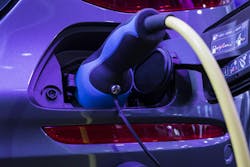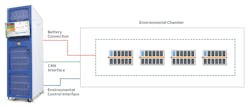New EV Battery Technologies and Trends Challenge Battery Test System Requirements
It is an exciting time in the automotive industry with the development and evolution of new technologies for electric vehicles (EVs). Specifically, battery technology is the key driving force for innovation in the industry. Battery manufacturers must overcome the two major challenges to consumer adoption and growth of the market: total driving distance between charges and charge time.
Battery manufacturers are researching new battery chemistries to achieve greater capacity and charge at higher rates without an increase in battery size. They are also making batteries using the existing battery chemistries, primarily lithium-ion and lithium phosphate, with higher voltage and higher Ah capacity battery packs.
The dynamics of the market pose challenges for testing EV battery packs. Since the battery pack is the most expensive component of an EV representing between 20% to 40 % of the vehicle cost and due to the safety issues with lithium-based batteries, test engineers must 100% test all batteries.
Rising battery pack voltages and increasing battery power and capacity add to the challenges of a growing market and higher throughput requirements. Thus, test systems need to be adaptable to evolving higher voltage and higher capacity battery packs, new battery chemistries and greater throughput demands.
The Existing State-of-the-Art
Today, lithium-ion is the most common EV battery chemistry. Lithium-ion batteries offer high energy density, but they have the risk of thermal runaway necessitating a cooling system for the battery pack to prevent a damaging overtemperature condition. Fully charged lithium-ion battery packs can provide a driving range of around 300 miles.
READ MORE: Navigating the Electric Mobility Path with Solid-State Batteries
Lithium-ion batteries made for the North American and European markets include either nickel, manganese and cobalt (NMC) or nickel, manganese, cobalt and aluminum (NMCA). Chinese battery manufacturers utilize lithium-iron-phosphate (LFP), which has a lower energy density than NMC- or NMCA-based lithium-ion batteries. Thus, a comparable capacity LFP battery must be larger than a nickel-manganese battery.
New Battery Chemistries
Several new battery technologies are under investigation. Some of the more promising new types include solid-state, lithium-sulfur, graphene and zinc-air batteries.
Solid-state batteries could double the range of EVs. Solid-state batteries have higher energy density than lithium-ion batteries and consume less space for an equivalent capacity battery. The electrolyte is a solid material such as a polymer, a ceramic or a glass. The anode can be graphite, silicon or lithium; the cathode can be a nickel-based material. Ions can move more quickly through the solid electrolyte allowing faster charging.
Without the highly reactive lithium electrolyte, the risk of thermal runaway is substantially reduced. The solid-state battery is a much safer battery and it requires a lower cost production process. Although still in the laboratory, Toyota is planning to have a solid-state battery in an EV by 2030.
Figure 1 illustrates the differences between a lithium-ion battery and a solid-state battery. The solid-state battery does not require a separator. As a result, it is smaller than the lithium-ion battery.
Researchers are investigating solid-state lithium-sulfur batteries that combine high energy density of lithium-sulfur with the safety and stability of solid electrolytes. In Europe, scientists believe that a lithium-sulfur battery has a lesser environmental impact than a Lithium-ion battery since cobalt is not a component of a lithium-sulfur battery. The most significant challenge to commercializing a lithium-sulfur battery is increasing its relatively short lifespan.
The nanotechnology material, graphene, is a single-atomic layer of carbon atoms that combines high charge carrier mobility, high thermal conductivity and high strength. Researchers are investigating a graphene-based battery for the EV market. Graphene batteries offer the benefits of a more rugged structure, lighter weight, and superior heat dissipation compared with lithium-ion batteries. Superior heat dissipation during discharging and charging reduces the risk of thermal runaway.
READ MORE:When Electric Vehicles Take Over
Graphene can also store larger amounts of energy per unit volume, and it can recharge at a higher rate. Unfortunately, challenges with graphene include scalable production, integration into existing battery manufacturing processes and cost-effectiveness. The emergence of a graphene battery will require some technological breakthroughs.
Zinc-air is another battery chemistry that is both inexpensive and capable of high power. The power derives from the oxidation of zinc. The oxidation process degrades battery performance over time. Commercialization of a zinc-air EV battery would require solving that problem.
Most likely, the automotive vehicle manufacturers will have several options for EV batteries. Each manufacturer will choose a battery technology or technologies that best suit the different types of vehicles that the manufacturer makes. Test systems will need to be adaptable to testing different battery types.
Higher Battery Voltage and Capacity
Higher battery voltage can make an EV more efficient and contribute to extended driving distance. For a given motor load, a higher battery voltage reduces the maximum current requirements. The vehicle can use smaller gauges and lighter cables. With less power lost in the cables and with less weight, vehicles can increase driving distance.
Many vehicle manufacturers have transitioned from 400 V to 800 V batteries to obtain the higher efficiency and lighter weight that a higher voltage offers. Larger electric vehicles such as trucks, trains and airplanes, could soon use even higher voltage batteries.
Constructing an 800 V battery requires a series combination of over 200 lithium-ion cells that generate a nominal voltage of 830 V. During regenerative breaking, the battery voltage can reach 860 V. Using a switching power supply for charging requires a circuit that operates 150 V to 200 V over the nominal battery voltage.
With 20% headroom for the circuit rails, the total maximum circuit voltage can be around 1300 V. A test system will require 1500 V to 2000 V to adequately test and charge an 800 V and higher voltage battery packs.
READ MORE: Lithium Forklift Batteries Find Second Life in Solar Energy Storage
Certainly, increased battery capacity can substantially increase driving distance. High performance vehicles incorporate 100 kWh to 135 kWh capacity. At least one manufacturer uses a 200 kWh battery in one of its vehicles. Some manufacturers are experimenting with battery capacities over 200 kWh. The battery packs used in high performance vehicles can deliver over 600 kW. Battery packs for heavy-duty commercial vehicles may need to deliver over 1 MW.
Growth projections for battery-specific energy over future time periods can be found here.
Higher Power and Faster Charging
Charging time compared with filling the tank of an internal combustion vehicle is a major barrier to EV adoption. High-power DC fast charging systems, categorized as Level 3 chargers, can deliver up to 350 kW and have the capability to add charge to a battery equivalent to as much as 200 miles in only 10 to 15 min.
Future charging systems will have megawatt power levels, primarily for heavy duty vehicles such as large trucks and high-performance cars. The expectation is that these chargers will deliver a high charging rate to large batteries and add 15–30 miles of range/minute. Advanced battery thermal management systems, larger battery packs and new battery chemistries could dictate even higher mile/minute charging rates.
Test System Requirements
Testing evolving EV battery packs requires systems that can support high battery and charger voltages and have increasing power capacity. At such high-power levels, safety is paramount. Also, enabling high throughput is essential for exponentially growing EV vehicle demand.
Battery pack voltages are already 800 V. As indicated in an earlier paragraph, the test system must be capable of sourcing (discharging) and sinking (charging) as much as 1,500 V. Future test systems may require 2000 V for batteries powering large vehicles.
To test battery packs with over 200 kWh capacity and the ability to deliver 600 kW, test systems will need to exceed the power capacity of the battery pack. High power combined with high voltage will enable the system to perform battery cycling to verify voltage-time discharge specifications and to estimate cycle life under fast charging conditions.
The battery test system needs high-power instrumentation that sources power for battery charging and sinks power for battery discharging. The test system could use individual power supplies and electronic loads; however, a bidirectional power supply which combines both the sourcing and the sinking function is the more cost-effective solution.
Bidirectional power supplies not only save costs compared with individual source and load instruments, but bidirectional power supplies also reduce the test system’s size, which consumes less manufacturing floor space. Furthermore, individual bidirectional power supplies, such as 10000 series models from EA Elektro-Automatik, can supply as much as 60 kW.
With the test system supporting hundreds of kilowatt and higher power levels, it can save substantial annual utility costs if the bidirectional power supplies are regenerative. A regenerative bidirectional power supply returns absorbed energy to the AC power grid.
Regenerative bidirectional power supplies are available that have greater than 95% efficiency. A test system with high efficiency energy recovery has lower cooling requirements which provides additional utility savings and can contribute to floor space savings.
In addition to the discharge and charge tests, the test system will also need to perform:
- Drive cycle simulations to conform to Federal Test Procedure (FTP-75)
- DC internal resistance measurement for assessment of battery state-of-health (SoH)
- Insulation resistance measurement to indicate whether the battery has one or more defects that can reduce efficiency or lead to a dangerous condition
- Pulse tests requiring the battery pack to deliver or absorb short high current bursts to quantify the state-of-charge (SoC) and performance of the battery cooling system.
To perform the pulse tests and the drive cycle simulations, the bidirectional power supplies in the test system must have high slew rates, and the test system must have high data acquisition rates for data capture. The test systems also need waveform generation capability to create the drive cycle test conditions.
To protect the battery pack-under-test and the test system, the test system should:
- Monitor battery temperature and disconnect the battery from the test system if the battery temperature reaches a safety limit
- Prevent reverse polarity connections
- Prevent applying a high charge current unless the battery is pre-charged to a safe level
- Ensure that all bidirectional power supplies share equal portions of the load so that no supply is overloaded
- Ensure safe connection of all paralleled power supplies for delivery or absorption of the maximum required power.
- Monitor and have alarm limits for overcurrent, overvoltage, overpower and overtemperature conditions on the bidirectional power supplies.
These protection features minimize the risk of damage to both the battery-pack-under-test and the test system. All the above requirements will ensure thorough test of an EV battery.
Addressing the Test Challenges with an Adaptable System
Protecting the investment in a battery test system will need a system that can adapt to the requirements of increasing battery capacity and growing production capacity. Systems need to easily add more power capacity. However, expanding the system power must not consume an inordinate amount of manufacturing space to avoid the need to expand the manufacturing plant.
The test system software needs to be capable of accommodating the charge and discharge characteristics of different battery types. Also, the software must be capable of adding new tests. In addition, the software must allow integration of more power instrumentation to both test higher power batteries and to simultaneously test multiple batteries to increase throughput.
The Solution for the Test Challenges of Evolution in Battery Technology and Capacity
An adaptable system that can easily increase its power, test different battery types, perform new tests and vary test sequences can overcome the test challenges of the dynamic EV battery market.
An example of one such adaptable battery test system is the EA Elektro-Automatik BTS 10300 Series Battery Cycler and Test System shown in Figure 2. This system conveniently allows addition of power test racks to offer future-proof performance.
About the Author

Russ Gaubatz
Senior Applications Engineer, SME, Tektronix + EA Elektro-Automatik
Russ Gaubatz is a senior applications engineer, SME at Tektronix + EA Elektro-Automatik and manages the Troy, Mich. Training and Test Center. Gaubatz is part of the team leading the advancement in battery testing technology, including the recently developed EA-BTS 10300.


